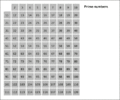In number theory, Proth's theorem is a theorem which forms the basis of a primality test for Proth numbers (sometimes called Proth Numbers of the First...
14 KB (2,109 words) - 16:31, 6 May 2025
larger than 1 would be Proth numbers. The primality of a Proth number can be tested with Proth's theorem, which states that a Proth number p {\displaystyle...
16 KB (1,684 words) - 23:24, 13 April 2025
Prime number (redirect from Euclidean prime number theorem)
specific number forms include Pépin's test for Fermat numbers (1877), Proth's theorem (c. 1878), the Lucas–Lehmer primality test (originated 1856), and the...
117 KB (14,179 words) - 16:20, 4 May 2025
Principal ideal theorem (algebraic number theory) Proth's theorem (number theory) Quadratic reciprocity theorem Ramanujan–Skolem's theorem (Diophantine equations)...
78 KB (6,293 words) - 12:16, 2 May 2025
stated four primality-related theorems. The most famous of these, Proth's theorem, can be used to test whether a Proth number (a number of the form k2n + 1...
3 KB (277 words) - 22:30, 24 January 2022
a = 3, and this special case of Proth's theorem is known as Pépin's test. Although Pépin's test and Proth's theorem have been implemented on computers...
46 KB (4,717 words) - 14:50, 21 April 2025
)+cn+d} for some constants c and d. For this recurrence relation, the master theorem for divide-and-conquer recurrences gives the asymptotic bound T ( n ) =...
13 KB (2,046 words) - 20:43, 4 May 2025
Euclidean algorithm (section Chinese remainder theorem)
it can be used as a basic tool for proving theorems in number theory such as Lagrange's four-square theorem and the uniqueness of prime factorizations...
126 KB (15,349 words) - 16:35, 30 April 2025
needed] For numbers of the form N = k · 2n + 1 (Proth numbers), either application of Proth's theorem (a Las Vegas algorithm) or one of the deterministic...
9 KB (1,066 words) - 09:10, 12 April 2025
Elliptic curve Pocklington Fermat Lucas Lucas–Lehmer Lucas–Lehmer–Riesel Proth's theorem Pépin's Quadratic Frobenius Solovay–Strassen Miller–Rabin Prime-generating...
27 KB (6,356 words) - 20:08, 10 April 2025
Elliptic curve Pocklington Fermat Lucas Lucas–Lehmer Lucas–Lehmer–Riesel Proth's theorem Pépin's Quadratic Frobenius Solovay–Strassen Miller–Rabin Prime-generating...
24 KB (3,043 words) - 18:51, 28 March 2025
exist for testing whether a number is prime, such as the Lucas test and Proth's test. These tests typically require factorization of n + 1, n − 1, or a...
27 KB (3,833 words) - 09:23, 3 May 2025
Elliptic curve Pocklington Fermat Lucas Lucas–Lehmer Lucas–Lehmer–Riesel Proth's theorem Pépin's Quadratic Frobenius Solovay–Strassen Miller–Rabin Prime-generating...
17 KB (1,993 words) - 13:05, 28 January 2025
This theorem is a generalization to polynomials of Fermat's little theorem. In one direction it can easily be proven using the binomial theorem together...
20 KB (2,447 words) - 14:35, 5 December 2024
always unique up to the order of the factors by the prime factorization theorem. To factorize a small integer n using mental or pen-and-paper arithmetic...
25 KB (2,983 words) - 11:39, 19 April 2025
Compute γ := g p e − 1 {\displaystyle \gamma :=g^{p^{e-1}}} . By Lagrange's theorem, this element has order p {\displaystyle p} . For all k ∈ { 0 , … , e −...
7 KB (1,035 words) - 18:44, 19 October 2024
Elliptic curve Pocklington Fermat Lucas Lucas–Lehmer Lucas–Lehmer–Riesel Proth's theorem Pépin's Quadratic Frobenius Solovay–Strassen Miller–Rabin Prime-generating...
21 KB (2,802 words) - 21:02, 4 May 2025
which is more accurate in the polynomial case, leading to the following theorem. If a and b are two nonzero polynomials, then the extended Euclidean algorithm...
28 KB (4,467 words) - 12:32, 15 April 2025
following description is based on (Hoffstein, Pipher & Silverman 2008, Theorem 6.68), with the corrections from the errata. INPUT a lattice basis b1,...
15 KB (2,154 words) - 05:33, 24 December 2024
Elliptic curve Pocklington Fermat Lucas Lucas–Lehmer Lucas–Lehmer–Riesel Proth's theorem Pépin's Quadratic Frobenius Solovay–Strassen Miller–Rabin Prime-generating...
2 KB (273 words) - 21:00, 30 September 2022
Elliptic curve Pocklington Fermat Lucas Lucas–Lehmer Lucas–Lehmer–Riesel Proth's theorem Pépin's Quadratic Frobenius Solovay–Strassen Miller–Rabin Prime-generating...
7 KB (1,061 words) - 19:23, 24 January 2025
Elliptic curve Pocklington Fermat Lucas Lucas–Lehmer Lucas–Lehmer–Riesel Proth's theorem Pépin's Quadratic Frobenius Solovay–Strassen Miller–Rabin Prime-generating...
13 KB (1,768 words) - 21:32, 26 September 2024
The idea behind the test was discovered by M. M. Artjuhov in 1967 (see Theorem E in the paper). This test has been largely superseded by the Baillie–PSW...
10 KB (1,517 words) - 18:46, 16 April 2025
Elliptic curve Pocklington Fermat Lucas Lucas–Lehmer Lucas–Lehmer–Riesel Proth's theorem Pépin's Quadratic Frobenius Solovay–Strassen Miller–Rabin Prime-generating...
13 KB (1,755 words) - 06:12, 18 April 2025
{\displaystyle 3^{16}\equiv 1{\pmod {17}}} —as follows from Fermat's little theorem— it also follows that if n {\displaystyle n} is an integer then 3 4 + 16...
17 KB (2,506 words) - 02:19, 27 April 2025
m_{p}} as the order of the group E p {\displaystyle E_{p}} . By Hasse's theorem on elliptic curves we know m p ≤ p + 1 + 2 p = ( p + 1 ) 2 ≤ ( N 4 + 1...
27 KB (4,793 words) - 03:13, 13 December 2024
number of solutions to 4x2 + y2 = n is odd and the number is squarefree (theorem 6.1 of ). All numbers n with modulo-sixty remainder 7, 19, 31, or 43 have...
14 KB (1,994 words) - 12:53, 8 January 2025
Elliptic curve Pocklington Fermat Lucas Lucas–Lehmer Lucas–Lehmer–Riesel Proth's theorem Pépin's Quadratic Frobenius Solovay–Strassen Miller–Rabin Prime-generating...
19 KB (3,750 words) - 05:13, 17 February 2025
Bertrand's postulate (redirect from Bertrand-Chebyshev theorem)
postulate is also called the Bertrand–Chebyshev theorem or Chebyshev's theorem. Chebyshev's theorem can also be stated as a relationship with π ( x )...
18 KB (2,606 words) - 01:41, 12 April 2025
theorem guarantees that the continued fractions algorithm will recover j / r {\displaystyle j/r} from k / 2 2 n {\displaystyle k/2^{2{n}}} : Theorem—If...
40 KB (5,853 words) - 21:33, 27 March 2025







